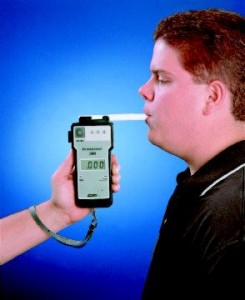How does a breathalyzer work?
Usually when you hear about people getting DUI’s, there will be some reference to the blood alcohol content (BAC) of the driver. If their blood alcohol content is over the legal limit of the state they are driving in, they are charged with Driving Under the Influence (DUI) or Driving While Intoxicated (DWI.) But just how do cops at the scene measure BAC? Are they taking blood tests in the field?
Cops use a device called a breathalyzer to measure a person’s blood alcohol content. A breathalyzer is a device that tests your breath to determine how intoxicated you are.
How does a breathalyzer work? Why test?
Cops needed a way to test BAC in the field that was practical. Sure, they could use urine or blood tests, but how would they do that on the side of the highway while pulling someone over? And with blood tests, they had to think about how to take blood in a sterile manner and the legal implications of such an invasive test. In the 1940’s, the breathalyzer was invented.
How does a breathalyzer work? Alcohol and your body.
Alcohol gets absorbed into your blood stream after you ingest it. Then, when the blood goes through the lungs, some of the alcohol moves across the membranes of the lung’s air sacs into the air, because alcohol will evaporate from a solution. So the amount of alcohol in the air sacs is proportional to the amount of alcohol in the blood stream. When the air in the air sacks is exhaled, you can test the air and figure out how much alcohol is in the blood stream. The proportion of breath alcohol to blood alcohol is 2,100:1. This means that 2100 ml of air from the air sacks will have the same amount of alcohol in it as 1ml of blood.
How does a breathalyzer work? Legal limits.
In many states, the legal limit is 0.08 BAC. This means you have 0.08 grams of alcohol in your system per 100 ml of blood. If your BAC is higher than that and you are considered too impaired to drive, you can be arrested.
How does a breathalyzer work? Chemical reaction.
The breathalyzer uses a chemical reaction involving alcohol to test a suspect’s breath. The suspect breathes into the device and the air goes into a solution of chemicals. The chemicals change color when they react to the alcohol. The degree of color change is proportional to the amount of alcohol in the air that was in the air. The device then produces an electric current in response to the amount of color change which causes the needle in the meter to move from its resting place. The operator then rotates a knob to bring the needle back to the resting place and reads the level of alcohol from the knob — the more the operator must turn the knob to return it to rest, the greater the level of alcohol.
How does a breathalyzer work? Accuracy.
The reading on a breathalyzer can vary up to 0.01 g/dl in any direction. Breathalyzers actually don’t measure blood alcohol content directly; they measure the alcohol on your breath and attempt to estimate your BAC. Only a blood test can give a truly accurate reading of blood alcohol level. Factors such as vomit or blood in the mouth, body temp and blood composition, and the presence of chemicals that are similar to alcohol can skew the results.


